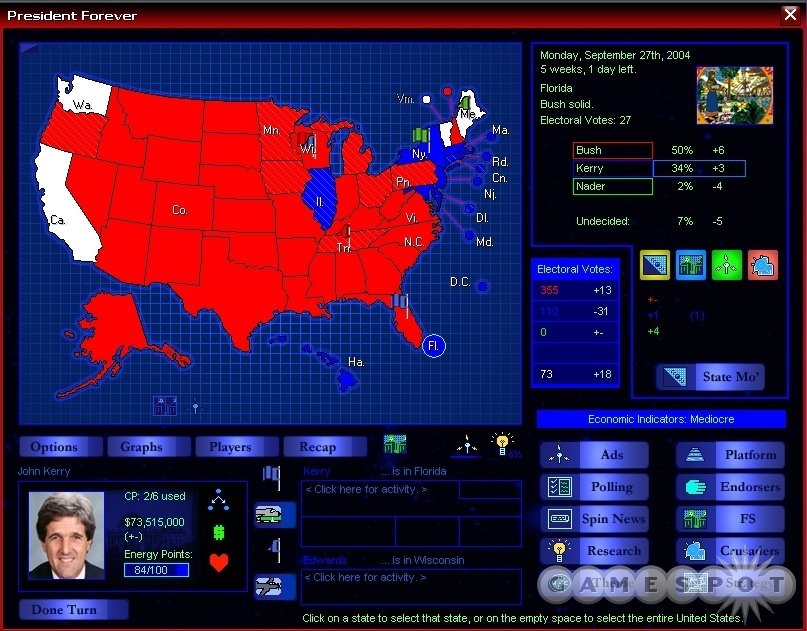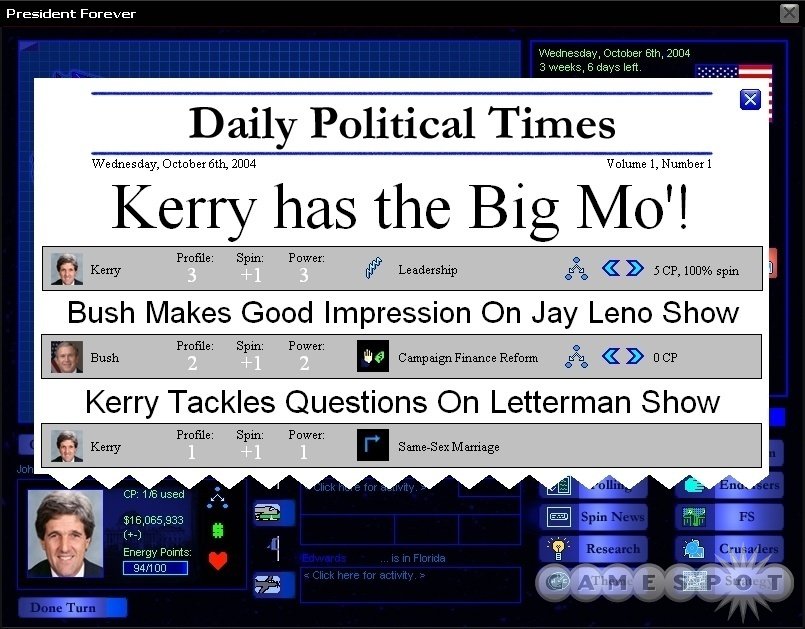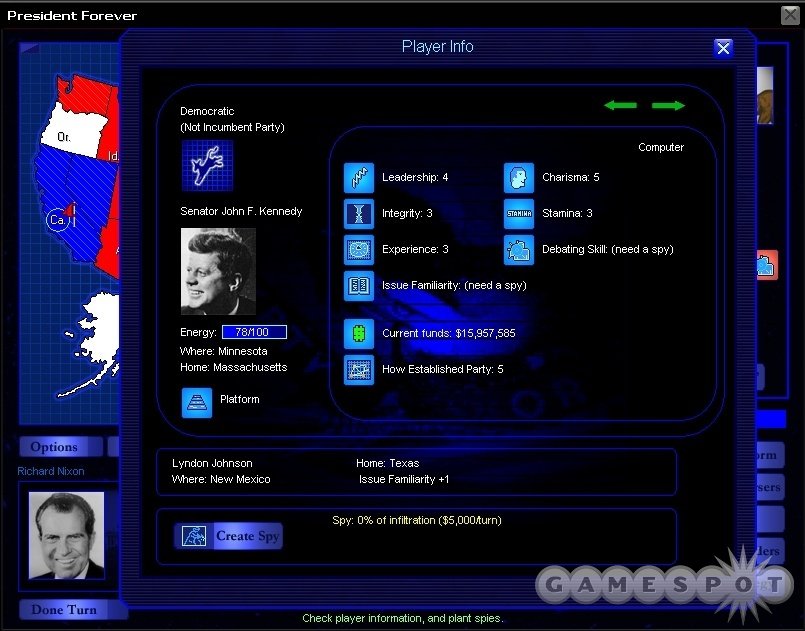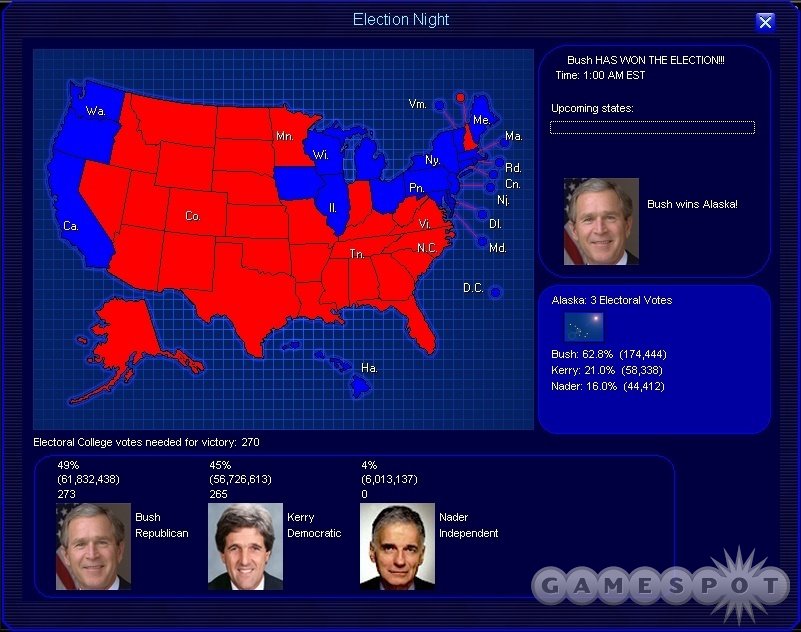Wondering how to occupy your time after the conclusion of one of the most hotly contested presidential elections in decades? Political junkies looking for a new diversion should check out President Forever, a simulation where the polls never close. Chances are that you'll never want them to, either, because this election simulation from Eighty Dimensional Software is very good. All the complexities of a grueling run for the presidency have been narrowed down to core themes, which make the daunting task of claiming the Oval Office addictive and playable while not sacrificing realism.

President Forever hangs its hat on a turn-based re-creation of the 2004 election, although the historically minded can choose from scenarios set in 1992, 1980, and 1960. Presidential wannabes John Kerry, Bill Clinton, Jimmy Carter, Ronald Reagan, Richard Nixon, Jack Kennedy, and, of course, Bush 41 and Bush 43 are included, along with a selection of 2004 also-rans like Colin Powell for the GOP and the likes of Howard Dean and Al Sharpton for the Democrats. Each comes with personal attributes like leadership and stamina that affect both their actions and how the voters view them. Additionally, the game is so customizable that dozens of historical and fantasy scenarios and candidates have been posted by modders at the game's official Web site. Online offerings range from pitting Lincoln against McLellan in 1864 to staging the first national election of the recently united US and Canada in 2008. There is something available for pretty much everyone.
No matter what scenario you select, each campaign begins when things really start to heat up in mid-September. Every decision is crucial, as people are going to the polls in under seven weeks. But even though the campaign schedule is shortened, long-term strategy is key. Polling numbers come out just once per week, meaning that you can't skew numbers and turn states simply by stepping off a plane and kissing a few babies. The idea is to set plans in motions that will show up in polling results down the road, and then to keep the numbers going up so that you build momentum.
A number of areas are critical to boosting voter support. First and foremost is your platform, which must establish your beliefs on 18 core issues. These change depending on the election in question--in 2004, for instance, the issues are military invention and terrorism, while in 1992 the hot-button topics are AIDS and Bosnia and Somalia--but you always set a stance that ranges from left to right. As in the real world, positions will win voters in some states and lose voters in others. Sticking near the center is almost a necessity to ensure good nationwide support, although you can't stray too far from the default settings because the opposition can attack you for inconsistency. In our first election with John Kerry, we moved him to the middle on abortion and free trade and were immediately greeted with Dubya spinning that into an attack for flip-flopping.

Of course, it isn't enough to just set a platform that people like. You need to visit each state to barnstorm, give policy speeches, and raise funds. Momentum-boosting endorsements can be earned from special interest groups. Foot soldiers and name crusaders (such as potential first ladies) can be recruited to help get your message out. Ad campaigns must be set up and launched, which takes time (five days are needed to maximize production values and to increase the chances by 50 percent of the ad becoming highly successful) and money (it costs $250,000 to produce a top ad in 2004). Also, limited funds means that you can only afford to launch ads in states where they can make a difference. Get greedy and you'll either go bankrupt or you'll fail to focus enough on battleground states. Finally, you can indulge in dirty tricks. News stories can be spun for both damage control and to turn the heat up on an opponent. And you can dig up scandals on opponents or hire spies to infiltrate an enemy's headquarters.
Everything is balanced in a subtle, elegant way through the use of energy and command points. Your starting pool of 100 energy points diminishes by giving speeches, holding fundraisers, and the like, and it doesn't fully replenish itself every turn (you get back a specific amount based on your stamina rating when you rest for a turn). You have to pace yourself over the long haul, as getting tired can lead to embarrassing gaffes during speeches and meet and greets. We ran Bill Clinton ragged during one 1992 campaign and pretty much lost the election in the final week by making mistakes when talking about social security in Florida.
Command points are more immediate, since they regenerate every turn, but they are far less numerous and even more critical to properly use. Making a policy speech, for instance, eats up a whopping four of the usual five command points, and holding a fundraiser consumes three, so you have to make every personal appearance count. Spinning news stories your way costs one command point for every 20 percent of spin as well, meaning that you can burn entire turns in damage control if a scandal breaks, or in building a positive story like a big debate victory. Recruiting foot soldiers and crusaders also takes a toll on command points, although the price is measured out over a number of turns depending on your momentum in the state in question.

The bottom line is that you never have enough command points to do everything that you want to do. There are always a dozen or more ways to spend the command points every turn. In one game where we were playing Jimmy Carter in a down-to-the-wire election with Ronald Reagan, a late-game turn presented us with so many sensible options that we took 10 minutes to decide on a course of action. We could spin a Reagan scandal, hold a fundraiser to build enough cash to extend the integrity of our ad campaign into Wisconsin, give a policy speech on social security to hopefully firm our numbers in Florida, barnstorm New York, or try to pull the military funding endorsement away from Reagan. All these choices were out there and were viable, yet we had just five command points to spend. Almost every decision in the game is fraught with tension, in that you never know whether you made the right or wrong move until the polls close on election night. Replay value is tremendous because there are so many legitimate paths to election day.
Certain results are, however, almost set in stone. Some states, for instance, are nearly impossible to win because of a high percentage of decided voters when the campaign begins. For example, Nixon was unable to take New York in over a dozen replays of the 1960 campaign. Constantly barnstorming the state, giving policy speeches, and recruiting loads of foot soldiers kept things almost even, but the numbers always plummeted as soon as we left to shore up positions elsewhere. While this makes perfect sense--Kennedy took the perpetually blue New York by over 5 percent in the real 1960 election, and of course some US regions are so solidly blue or red that you'd have to move heaven and earth to switch their voting patterns--realism only goes so far. Regionalism can be turned off, but that just makes the entire US homogenous and causes issues to be viewed the same way in San Francisco as they are in Sheboygan.
Another slight problem is the interface. The main map screen and menus are pretty dry. Buttons are smaller than they should be, as are text and numbers, and it takes a couple of campaigns to figure out where everything is. Feedback is too sparse. We're still not quite sure how endorsements work, and there aren't enough details provided into how research works. Some issues could use more personalization, as well. Seeing "BUSH SCANDAL" trumpeted on the front pages is always gratifying for the Kerry camp, but it would be more interesting if we got to learn the specifics behind the media ruckus.

Information isn't presented as well as it should be, and the system presenting nationwide and state numbers in the upper right box of the main menu isn't user-friendly. There also aren't enough statistical breakdowns that give you advice on how to focus your campaign. You can't just click on Oregon, for instance, look at tracking numbers, and decide on whether or not your ecology policy speech would go over well there, because there aren't any such tracking numbers. All you can do is keep a close watch on the daily recaps and look at how your platform issues are playing in different states.
Even with these flaws, all of the above--combined with an appealing $12 price tag to download the full version of the game from the 80soft Web site (the game can only be purchased online)--makes President Forever a winning choice no matter which political party you support. It's an ideal option to keep people inside and outside of the Washington Beltway now that the 2004 election is history.